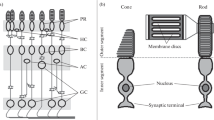Some animals are known to be able to react to very small changes in the magnetic field (a thousand times smaller than the geomagnetic field) and to use this ability to navigate the Earth’s magnetic landscape. However, the nature of the molecular sensor of the magnetic field remains uncertain, though it has been established that the magnetic sense is associated with vision. A magnetochemical reaction is believed to underlie the functioning of the magnetic sensor. The cryptochromes of photoreceptors lining the retina contain photoinduced spin-correlated pairs of radicals which are involved in forming nerve impulses and are sensitive to magnetic fields. On this basis, animals may sense the magnetic field as changes in brightness over large visual fields, and orient themselves in terms of the contrast of these fields. However, the sensitivity of individual sensors – radical pairs – is very low. It has previously been supposed that this difficulty is overcome by a statistical increase in contrast sensitivity due to the parallel processing by the brain of the primary signals of millions of photoreceptors. We report here testing of this hypothesis. The threshold sensation of brightness contrast was found to depend almost linearly on the logarithm of the angular size of the contrasting stimulus, which is typical for the physiology of sensations obeying the Weber–Fechner law. Contrast sensitivity increases with increases in the number of photoreceptors involved in stimulus recognition, though this increase is quantitatively insufficient to provide a confident explanation of magnetic navigation in animals.
Similar content being viewed by others
References
Astakhova, L. A., Rotov, A. Yu., Kavokin, K. V., et al., “Relationship between the magnetic compass and photoreception in birds: hypotheses and unresolved issues,” Zh. Obshch. Biol, 80, No. 2, 83–94 (2019), https://doi.org/10.1134/S0044459619020040.
Bertalmio, M., Vision Models for High Dynamic Range and Wide Colour Gamut Imaging, Academic Press, London (2020).
Binhi, V. N. and Prato, F. S., “Biological effects of the hypomagnetic field: An analytical review of experiments and theories,” PLoS One, 12, No. 6, e0179340 (2017),https://doi.org/10.1371/journal.pone.0179340
Binhi, V. N. and Prato, F. S., “Rotations of macromolecules affect nonspecific biological responses to magnetic fields,” Sci. Rep., 8, No. 1, 13495 (2018), https://doi.org/10.1038/s41598-018-31847-y.
Blackwell, H. R., “Contrast thresholds of the human eye,” J. Opt. Soc. Am., 36, No. 11, 624–643 (1946).
Buchachenko, A., Magneto-Biology and Medicine, Nova Science, New York (2014).
Crumey, A., “Human contrast threshold and astronomical visibility,” Monthly Not. Royal Astron. Soc., 442, No. 3, 2600–2619 (2014), https://doi.org/10.1093/mnras/stu992.
Curcio, C. A., Sloan, K. R., Kalina, R. E., and Hendrickson, A. E., “Human photoreceptor topography,” J. Comp. Neurol., 292, No. 4, 497–523 (1990).
Dombrugov, R. M., Television, Vishcha Shkola, Kiev (1979).
Hore, P. J. and Mouritsen, H., “The radical-pair mechanism of magnetoreception,” Annu. Rev. Biophys., 45, No. 1, 299–344 (2016), https://doi.org/10.1146/annurev-biophys-032116-094545.
Krasil’nikov, N. N. and Shelepin, Yu. E., “A functional model of vision,” Optich. Zh., 64, No. 2, 72–82 (1997).
Kucheryavyi, A. A., Onboard Information Systems, Ul’yanovsk State Technical University, Ul’yanovsk (2004).
Lohmann, K. J., Lohmann, C. M., Ehrhart, L. M., et al., “Animal behaviour: geomagnetic map used in sea-turtle navigation,” Nature, 428, No. 6986, 909–910 (2004), https://doi.org/10.1038/428909a.
Murav’eva, S. V., Pronin, S. V., and Shelepin, Yu. E., “Contrast sensitivity of the human visual system,” Eksperim. Psikhol., 3, No. 3, 5–20 (2010).
Nadler, M. P., Miller, D., and Nadler, D. J. (eds.), Glare and Contrast Sensitivity for Clinicians, Springer-Verlag, New York (1990).
Pelli, D. G. and Bex, P., “Measuring contrast sensitivity,” Vision Res., 90, No. 10–4 (2013), https://doi.org/10.1016/j.visres.2013.04.015.
Pishchalnikov, R. Y., Gurfinkel, Y. I., Sarimov, R. M., et al., “Cardiovascular response as a marker of environmental stress caused by variations in geomagnetic field and local weather,” Biomed. Signal Proc. Contr., 51, No. 401–410 (2019), 10.1016/j bspc 2019 03 005.
Riccó, A., “Relazione fra il minimo angolo visuale e l’intensità luminosa,” Memorie della Societa Degli Spettroscopisti Italiani, 6, No. B29–B58 (1877).
Schulten, K., Swenberg, C., and Weller, A., “A biomagnetic sensory mechanism based on magnetic field modulated coherent electron spin motion,” Z. Phys. Chemie, 111, No. 1, 1–5 (1978).
Stöckl, A. L., O’Carroll, D. C., and Warrant, E. J., “Neural summation in the hawkmoth visual system extends the limits of vision in dim light,” Curr. Biol., 26, No. 6, 821–826 (2016), https://doi.org/10.1016/j.cub.2016.01.030.
Wan, G., Hayden, A. N., Iiams, S. E., and Merlin, C., “Cryptochrome 1 mediates light-dependent inclination magnetosensing in monarch butterflies,” Nat. Commun., 12, No. 1, 771 (2021), https://doi.org/10.1038/s41467-021-21002-z.
Watson, A. B. and Ahumada, A. J., “A standard model for foveal detection of spatial contrast,” J. Vis., 5, No. 9, 717–740 (2005), https://doi.org/10.1167/5.9.6.
Weisstein, E. W., “Beta binomial distribution,” in: MathWorld – A Wolfram Web Resource, https://mathworld.wolfram.com/BetaBinomialDistribution.html, acc. July 18, 2022.
Author information
Authors and Affiliations
Corresponding author
Additional information
Translated from Sensornye Sistemy, Vol. 37, No. 1, pp. 35–48, January–March, 2023.
Rights and permissions
Springer Nature or its licensor (e.g. a society or other partner) holds exclusive rights to this article under a publishing agreement with the author(s) or other rightsholder(s); author self-archiving of the accepted manuscript version of this article is solely governed by the terms of such publishing agreement and applicable law.
About this article
Cite this article
Binhi, V.N. Magnetic Navigation in Animals, Visual Contrast Sensitivity and the Weber–Fechner Law. Neurosci Behav Physi 53, 1036–1046 (2023). https://doi.org/10.1007/s11055-023-01497-3
Received:
Accepted:
Published:
Issue Date:
DOI: https://doi.org/10.1007/s11055-023-01497-3




